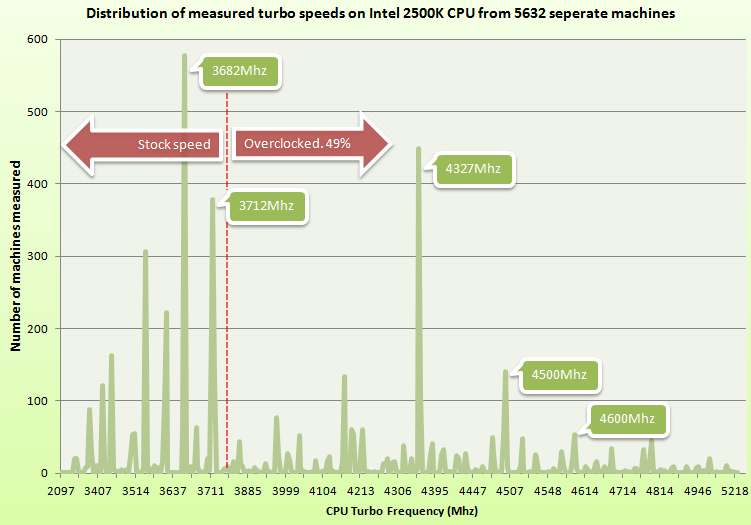After our study of the 'Distribution of benchmark results for Intel i5 CPUs' we decided that we could improve the accuracy of the charts by better filtering of the overclocked machines.
What we were doing up until today (2/Feb/2012) was including a CPU in the standard benchmark chart if the measured base clock speed of the CPU was within 15% of the factory specified speed. Anything over 15% got moved to the overclocking chart.
While it could be argued that the 15% level wasn't strict enough, this worked pretty well in the past. A 3.0Ghz CPU found to be running at less than 3.3Ghz at base speed got put into the standard chart, while anything at 3.3Ghz and above was classified as overclocked. But with the introduction of the Turbo Boost feature in Intel i5 and i7 CPUs new ways of overclocking are now available. It is now possible (and even common) to overclock just the turbo speed of the CPU, leaving the base speed unchanged, or only slightly changed.
The result was that CPUs that had overclocked turbo multipliers were slipping through the overclocking detection algorithm. The main noticeable consequence of this was that the 'K' series CPUs (e.g. Core i5-2500K, i7-2600K, i7-2700K, etc..) were ranking higher than they should have been in the standard charts.
From today we are adding new data into the database on factory and measured turbo clock speeds and tweaking the algorithm to trigger the overclocking flag based on either overclocking of the base speed, or overclocking of the turbo speed. We are also going to change the criteria for what is overclocked from 15% of the clock speed to 90Mhz difference from the factory speeds. This will mean even lightly overclocked CPUs are now going to moved into the overclocked chart. Hopefully this won't result in too many false positives.
The result will be a bunch of CPUs with high benchmark results being moved from the standard chart to the overclocking chart.
We think the 'K' series CPUs will still rank better than their almost identical non K counterparts for other reasons however. But this should narrow the gap and improve the accuracy of the charts.
What we were doing up until today (2/Feb/2012) was including a CPU in the standard benchmark chart if the measured base clock speed of the CPU was within 15% of the factory specified speed. Anything over 15% got moved to the overclocking chart.
While it could be argued that the 15% level wasn't strict enough, this worked pretty well in the past. A 3.0Ghz CPU found to be running at less than 3.3Ghz at base speed got put into the standard chart, while anything at 3.3Ghz and above was classified as overclocked. But with the introduction of the Turbo Boost feature in Intel i5 and i7 CPUs new ways of overclocking are now available. It is now possible (and even common) to overclock just the turbo speed of the CPU, leaving the base speed unchanged, or only slightly changed.
The result was that CPUs that had overclocked turbo multipliers were slipping through the overclocking detection algorithm. The main noticeable consequence of this was that the 'K' series CPUs (e.g. Core i5-2500K, i7-2600K, i7-2700K, etc..) were ranking higher than they should have been in the standard charts.
From today we are adding new data into the database on factory and measured turbo clock speeds and tweaking the algorithm to trigger the overclocking flag based on either overclocking of the base speed, or overclocking of the turbo speed. We are also going to change the criteria for what is overclocked from 15% of the clock speed to 90Mhz difference from the factory speeds. This will mean even lightly overclocked CPUs are now going to moved into the overclocked chart. Hopefully this won't result in too many false positives.
The result will be a bunch of CPUs with high benchmark results being moved from the standard chart to the overclocking chart.
We think the 'K' series CPUs will still rank better than their almost identical non K counterparts for other reasons however. But this should narrow the gap and improve the accuracy of the charts.



 Sorry no offense, but it all just sounds like a bunch of marketing fud to me. I guess I'm just that 1% that looks at numbers like everybody else looks at shiny objects. I would rather see factual scores of something that's real though rather then a score calculated with magic (although I do love the magic
Sorry no offense, but it all just sounds like a bunch of marketing fud to me. I guess I'm just that 1% that looks at numbers like everybody else looks at shiny objects. I would rather see factual scores of something that's real though rather then a score calculated with magic (although I do love the magic  )... But you're right, it would only be useful to that 1% and it is a lot of work and a lot of data to collect.
)... But you're right, it would only be useful to that 1% and it is a lot of work and a lot of data to collect.
 I got a lot more reading to do.
I got a lot more reading to do. 
Comment